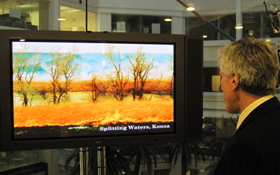March 28, 2013
Pride of the Prairie: National Science Foundation features artwork inspired by Konza Prairie
Submitted by Communications and Marketing

The artistry of spring burning at Kansas State University's Konza Prairie Biological Station is blazing a path in the Washington, D.C., area.
The National Science Foundation's Long-Term Ecological Research, or LTER, art exhibit, "Ecological Reflections: Sense of Place in Changing Places," features photographic and literary art from two Kansas State University faculty members. Poems by Elizabeth Dodd, university distinguished professor of English, and photos by Edward Sturr, professor emeritus of art and a photographer, depict the tallgrass prairie's annual spring burning -- as well as additional Konza Prairie-inspired pieces.
The exhibit is on display through June 15 and features 39 artists from 11 Long-Term Ecological Research sites. The artwork is displayed on more than 200 feet of wall space at the National Science Foundation headquarters in Reston, Va. In addition to the Konza Prairie, the exhibit features art inspired by ecological landscapes at a variety of locations, including Florida's Everglades, Alaska's Arctic tundra and boreal forests, and Oregon's old growth forests.
"Fire as a theme showed up at a lot of different sites," said Clarisse Hart, exhibit organizer and outreach and education manager at Harvard Forest, a Long-Term Ecological Research site and a department of Harvard University. "Konza Prairie's fire images are really compelling and comparing that -- from a scientific perspective -- to what a spruce fire in Alaska means to the ecosystem is really interesting."
Dodd submitted two poems to the art exhibit and Sturr submitted multiple photographs. One of Dodd's poems and all Sturr's photographs are from the book they published together titled "Fire and Form on the Konza Prairie." The other poem by Dodd is from her book, "Like Memory, Caverns."
Jointly owned by Kansas State University and The Nature Conservancy, Konza Prairie was one of the first six Long-Term Ecological Research sites established by the National Science Foundation more than 30 years ago. The Konza is divided into many research areas called watersheds that are burned at intervals ranging from every year to every 20 years. To preserve research integrity, the majority of the 8,600 acres are closed to the public.
"Very few individuals will have the opportunity to get anywhere near to see up close and fully experience such burns, but with my photographs they may see a violent fire form caught in a millisecond exposure that is both terrifying and beautiful," Sturr said. "Such fire form images are also aesthetically enriched by the changing geographic context in which the controlled burns on the Konza are conducted."
Because everyone cannot experience the power of a prairie fire or the calming effect of the prairie's wildlife, the director of Konza Prairie, John Briggs, is working to bring the arts humanities together with the sciences to increase ecological understanding and appreciation of the natural world.
"I hope that individuals who are not familiar with the tallgrass prairie will appreciate it more by seeing the beauty of the place," Briggs said. "Also, I hope that by getting new insights into the tallgrass prairie with the merging of arts and sciences that we will understand more about the natural world and the place of humans in the world."
Both Dodd and Sturr have a deep passion for Konza and their art is their way of expressing the terrain's beauty and rarity.
"There's so little tallgrass left on earth -- less than 5 percent of the presettlement grasslands in North America, which is an even smaller percentage than the remaining old-growth forests -- so it's an especially rare ecosystem," Dodd said. "Since I live in tallgrass country, I've come to feel a bit responsible for its appreciation and preservation."
"The complex visual relationships created by the tall grasses, sky, clouds and ground, varying geographic formations, trees and creeks, limestone outcrops, and rolling hills are the unique features that become subjects for camera work," Sturr said. "My intent is not to document the physical aspects of the Konza, but rather to respond to and make visible in my photographs the expressive nature of such features. The dynamic, ever-changing prairie with its energy, force and living power is what makes me light up."
An opportunity very few are allowed, Sturr has worked alongside the Konza Prairie burn team to photograph the prairie fires nearly every year since 2001.
"It was by being so close to the burn action that I was able to create the images seen in the book," Sturr said.
Dodd is a member of the Friends of Konza Prairie and serves as volunteer for Konza Prairie's burn team. It is through this experience that she has met many of the prairie's researchers and has gained an understanding of the science behind her inspiration.
"From the scientists who explore its ecology, I've learned just enough to change my view of the landscape as a noun, a static image, to a verb, an ongoing happening of many intermingled forces," Dodd said.
Entrance into the National Science Foundation headquarters is by appointment only. To view the art exhibit contact Dorothy Harris, National Science Foundation Art of Science coordinator, at dharris@nsf.gov to reserve an identification badge.
